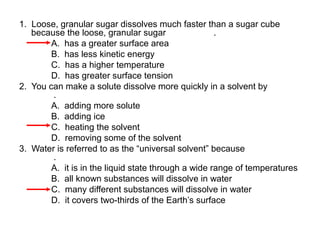
Solubility curves
- 1. 1. Loose, granular sugar dissolves much faster than a sugar cube because the loose, granular sugar . A. has a greater surface area B. has less kinetic energy C. has a higher temperature D. has greater surface tension 2. You can make a solute dissolve more quickly in a solvent by . A. adding more solute B. adding ice C. heating the solvent D. removing some of the solvent 3. Water is referred to as the “universal solvent” because . A. it is in the liquid state through a wide range of temperatures B. all known substances will dissolve in water C. many different substances will dissolve in water D. it covers two-thirds of the Earth’s surface
- 2. Review • Universal solvent • Likes dissolve likes • Speeding up dissolving rates
- 3. Speeding up the dissolving process 1. Shaking or stirring the solution 2. Increase the surface area of the solute 3. Raising the temperature of the solvent
- 4. The Affect of Changing the Solvent Temperature on the Dissolving Rate 120 Time (sec.) 100 80 60 40 20 0 0 20 40 60 Temperature (C) 80 100
- 5. Solubility and Concentration • Concentration- the quantity (how much) of a solute is in a solution • Concentrated- a lot of solute dissolved • Dilute- a small amount of solute dissolved
- 6. Solubility and Concentration • Saturated- can not hold any more solute • Unsaturated- can hold some more solute
- 7. Solubility and Concentration •Supersaturated •Holds more solute than it normally can
- 8. Solubility Curves • Increasing the temperature increases the dissolving rate • It also increases the amount of solute a solvent can hold We know this from the previous lab!
- 9. Solubility Curves •In general: higher temperatures means water will hold more solid solutes
- 11. Solubility Curves •In general: higher temperatures means water will hold less gaseous solutes